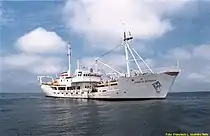Wladimir Besnard (1890, St. Petersburg, Russia – 1960, São Paulo, Brazil) was a French biologist [1] and Brazilian oceanographer, and is considered to be the father of Brazilian oceanography.[2]
He was born in the Russian Empire of French parents.
As a biologist he is credited (together with Theodore Monod) with the discovery of the skeleton of the Asselar man in 1927 [2][3] (although various sources refer to him as M.M. Besnard or M.V. Besnard).
An oceanographic ship, some undersea features (Besnard Bank, Besnard Passage[4]), and a street in São Paulo (Rua Professor Wladimir Besnard) are named in his honor.
Oceanographic ship

During 1967–2008 Brazil operated Professor W. Besnard, its only oceanographic vessel at that time. The ship was launched on August 18, 1966, from the shipyard Mjellem & Karlsen, Norway, and belonged to the Institute of Oceanography of the University of São Paulo. In 1988 the ship suffered damage from a fire. In 2012 a new ship, Alpha Crucis, has replaced the Professor W. Besnard.[2][5]
References
- ↑ "Wladimir Besnard" at neglectedscience.com
- 1 2 3 Homenagem aos mestres: esculturas na USP, vol. 5 of "Cadernos CPC", 2002, ISBN 8531406862, Biographical sketch of W. Besnard
- ↑ "Théodore MONOD Souvenirs sahariens d'un vieux géologue amateur.", TRAVAUX DU COMITÉ FRANÇAIS D'HISTOIRE DE LA GÉOLOGIE - Deuxième série - T.4 (1986)
- ↑ 22nd Meeting of the GEBCO Subcommittee on Undersea Feature Names Items 73a, 73d
- ↑ "Novo navio oceanográfico da USP já está a caminho do Brasil"